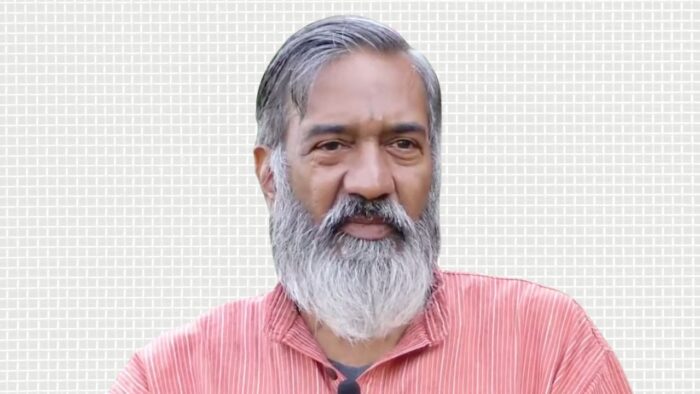My first interaction with Raghu Ananthanarayananji was during Indica Yoga’s Global Festival of Yoga, and then, a few months ago, I hosted Raghuji on Indica Yoga’s Yoginsights where he spoke about his new book, Five Seats of Power: Leadership Insights from the Mahabharata: Discovering the Best You Can Be through the Mahabharata. At the end of the session, one of the participants asked Raghuji how to deal with strong opinions or judgement and Raghuji’s answer was, “understand the difference between being judgmental and practising intellectual discrimination.” This advice from Raghuji corrected a recurring pattern I have of being judgemental. A trait I inflict on people closest to me but I never thought of it as being judgemental until I discovered the meaning of what it is to practise intellectual discrimination.
It was the first thing I mentioned to Raghuji when we spoke for this interview because I’ve been fortunate to interact with some of India’s most authentic yoga and Vedanta teachers and often, a simple act or a simple sentence has a profound effect on my spiritual progress. Raghuji has also been fortunate to interact with some of India’s spiritual stalwarts and he spent time learning with Yogacharya Tirumalai Krishnamarcharya, TKV Desikachar, and J. Krishnamurthi. I asked him about the time he spent with them. “I met Krishnamurthi when I was going through some very difficult periods in my life. I had the good fortune of having quite a few one-on-one conversations with him. Before I met him, I had read a couple of books and heard a lot about him so one goes into a meeting with such people thinking of some Buddha-like figure having built a huge mythology in one’s head (laughs). In the first meeting that I had, it was a very simple conversation. He asked me things like, ‘what's your name?’ ‘Where do you live?’ ‘Where do you work?’ It was a regular conversation like I would have with anyone else except with him, I could sense a deep presence. But the conversation itself was very simple. That was very important for me because it put me in touch with the fact that what I thought I had understood about Krishnamurthi through reading his books, was actually me bouncing my own ideas and pretending to understand Krishnamurthi. This was a huge eye-opener because whenever we read, whenever we listen, unless our listening comes from a place of a lot of quietness, we’re just projecting our own ideas back to ourselves and pretending that we understand. I've had other meetings with him subsequently and he's really helped me look at myself and what it means to really be inward. This was very critical and I think this helped me in my subsequent meetings with him. To be able to listen to him without projecting my own expectations, my own illusions about him or what his words might mean. I had an ongoing relationship with him for about 10 to 12 years. I was part of the Krishnamurti Foundation in Chennai. I had met Krishnmaurthi around a year before I met Desikachar and Krishnamacharya. My aunt and cousins were long-term students of the family and when I started studying with him, it was deeply impactful from the very first asana class. I could experience the subtlety of the process so I committed myself to studying and did that for around 12 years. After a year or so, Desikachar told me to start teaching and that’s a good thing because when you start teaching, you pay a lot more attention to your own practice. You start delving much deeper into the subject. In fact, when I started teaching, I was asked to come for classes with Krishnamacharya. I had the pleasure of studying the Yoga Sutras with Krishnamacharya. I have studied them with him three or four times and each time he would dig deeper and deeper and he always linked everything with the sutras so that was the central text for us for 12 years.”
In addition to Krishnamarcharya, TKV Desikachar, and J. Krishnamurthi, Raghuji was also influenced by Dharampalji and Dr Sheshadri — they started the People's Patriotic Science and Technology. “Dr Sheshadri was a very well-known physicist and he would always ask the question, ‘what are you doing for India?’ ‘Are you going to run behind the tails of the West or make India great again?’ (laughs). I founded Ritambhara Ashram as a coming together of all of the above influences. I teach a lot of transformation work based on the Yoga Sutras and my wife Shashi, talks about inner and outer order. She teaches architects the principles of design. These are very profound as they bring the inner and outer together,” explained Raghuji. “The ashram addresses how to apply yoga to life. How to understand yoga as an inner transformation and how to live a dharmic life.”
Indic culture and especially India’s spiritual culture is now being practised globally. I often ask myself this question all the time. What does it mean to be a contemporary Indian? I asked Raghuji, too. “India has always engaged openly with all cultures. So even if you go back all the way to the Vedic times. The vedas are not one monolithic writing. It talks about the experiments of various people in various dimensions. There are discussions on linguistics in the Vedas, there are discussions on geometry, on proportions — it is a vast enquiry that has been put together. There is a core in Indian thought — which I think is a very important part of Indian thought that distinguishes itself from most other things — that very early in the Vedas and Upanishads, it says that the idea of God is created by man, and the real Brahman is way past all these ideas of God. So once you have a basis like this, and you also have a basic idea that says there are many parts to truth and nobody can encompass truth in their minds, you have a very open structure of thinking, of dialoguing, and this is very critical to Indian science, to Indian spirituality, to everything. So you see, India has always been contemporary. We’ve lost that contemporary way of thinking in recent times. For some very obvious reasons. One is through the various colonising processes that happened in India and so this openness has shrunk, and we've become more and more conservative. So this kind of attack on Indian thought has resulted in a lack of certain conviction and pride that you need in yourself in order to engage with other forms of thought as an equal and that openness has got lost. When we meet people like Dharampalji, we understand how much history has been distorted because he did a lot of work in bringing back history in terms of Indian agriculture, Indian metallurgy, Indian governance practices and so many such practices. When you start to understand the continuity of this kind of history, that’s when we can regain a sense of self-worth and self-pride that had been damaged with colonisation. When we regain that sense of self-pride and connect with our history and culture, we can make India great again and that’s when we will be contemporary Indians. For example, there is no idea in physics that will sound surprising to a student of Sankhya or yoga and Vedanta. The structure of the cosmos that Sankya puts through is very compatible with modern science. For example, the Yoga Sutra has a word, ‘kshana’ in it and this word is described in a way that any scientist would agree. The sutras say that a ‘kshana’ is the time taken for a subatomic particle to move from its current position to its immediate next position. That is the definition of time and no scientist would disagree. So my contention is that by really understanding what is Indian deeply, we can understand science without getting caught up with the limitations of science whereas in Western frameworks, science is often at a tussle with religion. We don't have that fight between science and spirituality, which is great. So we are gifted with stuff that can make us traditional and contemporary simultaneously without any problem at all.”
Everytime I interview a senior scholar of Indian knowledge systems, I have to enquire about the purpose and role of meditation. As a Vipassana practitioner, I know the value that a seated meditation practice can have on spiritual progress so I asked Raghuji about when a student or practitioner should move from asana practice to more subtle practices. “There are many ways of looking at this. What Krishnamacharya would say is that when you start having some facility with asana practice, unless the asana is something you are doing dharana on, it is not yoga. Or if you are doing pranayama and you are not doing it with deep, attentiveness, it is not yoga. The ability to be attentive — in the body if you are doing asana, in the breath if you are doing pranayama, to be attentive to the people you are interacting with — there are many sutras that talk about the importance of looking at how we engage with the world. So all of these are objects of meditative enquiry. The word Dhyana does not mean the same in every chapter. So it has a nuanced meaning. In chapter 2, the way dhyana has to be understood is ‘how do I pay attention to various aspects of myself in a way that I cleanse it of all the samskaras and vasanas.’ Now unless you are cleansed in your psyche and soma of samskaras and vasanas, when you so-called ‘sit’ for meditation what will happen is that those parts of your mind and body that are still holding anxiety and tension, will trigger your mind. So when you sit quietly, the triggers don’t come from the outside, they come from inside. So that second chapter helps to look at how to understand the inside and the outside through various practices and Viveka — that enables you to understand where you’re coming from in terms of your response — is it coming from avidya or abhinivesha…Unless we withdraw our pranic energy from all the tension points or granthis and quieten our trigger points, the mind won’t become silent…insight comes when the mind can observe quietly. Whatever we pay attention to, we get a deep understanding of. So the English word meditation implies Bhavana (exercises to observe and train the mind) more than dhyana, dharana and Samadhi that the Yoga Sutras talk about. So things like mantra chanting or asana practice help you to quieten the mind, pay attention to your mind or see what is causing distractions in the mind and through these practices the samskaras and vasanas dissolve…So it is not a question of ‘either-or’ (in terms or asana vs meditation)...,” explained Raghuji.
I had only a question or two left to ask Raghuji and this interview would come to an end but I was thinking about everything Raghuji spoke about for days. The last advice he gave me at the end of the interview applies to every yoga student and teacher. Raghuji advises that, “Look at what we are doing to the world because we don’t take our lives seriously and we don’t take responsibility. The first step in yoga is to accept that the things we do to ourselves and the people around us can cause dukha or suffering. When we say Atha Yoga Anushasanam, the word Atha asks if one is ready to step into yoga and without considering this question with at least some sincerity, you are not on the path of yoga. You might be doing asana practice — that doesn’t make it yoga. When you start taking responsibility for yourself, for the dukha that is caused in you and the world around you, that is when you really step into yoga.”





